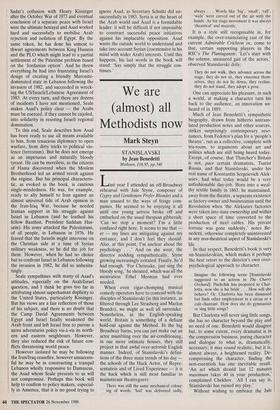Sympathetic view of a formidable leader
Anthony Parsons
ASAD: THE STRUGGLE FOR THE MIDDLE EAST by Patrick Seale I. B. Tauris, f17.95, pp.552 Patrick Seale has a remarkable gift: he is able to illuminate the serpentine con- volutions of Syrian politics and make his account of them readable and compre- hensible. He demonstrated this in his first book, The Struggle for Syria, now a classic, and this biography of President Asad, aptly subtitled 'The Struggle for the Middle East', is a worthy successor. Its authentic- ity is reinforced by the large number of personal interviews (including many with Asad himself) on which much of the narrative is based. This factor has, of course, imparted to the book a strong element of the 'view from Damascus'. But, although Seale takes trouble to explain the motivations behind Asad's murkier deeds (of which there have been plenty) he does not gloss over them: this is not an uncritical eulogy.
The early chapters throw fascinating light on Asad's origins in a peasant com- munity in a remote rural area, peopled by the Nusayri (Alawi) sect, an esoteric offshoot of Shia Islam. It was evidently a hard, grinding pilgrimage to the higher ranks of the Syrian Air Force, followed by a grim, bloody struggle to absolute power. Asad emerges as very much a product of the 'decades of the officers', the period (1949-1970) in which Colonel Nasser over- threw King Farouk of Egypt, General Abboud the Sudanese independence gov- ernment, Brigadier Abdul Karim Qasim the Hashemite monarchy in Iraq, Colonel Qaddafi the Idrisid King of Libya, and Syria underwent coup after military coup. Asad has now reigned supreme for 18 years, his rivals, even members of his own family, having been driven off by death, imprisonment, disgrace or exile. Seale depicts a man whose devotion to his mission has obscured his human qualities, who is dangerously isolated in power, controlling a polity perilously dependent on his survival, the vaunted Baath party organisational structures being merely pap- er houses easily demolished by a strong hand.
Two thirds of the book are devoted to the 'Struggle for the Middle East', namely Asad's campaign against what he sees as an American-backed Israeli conspiracy to divide and weaken the Arab world, thus facilitating Israeli hegemony and extin- guishing all hope of the recovery of Palesti- nian rights. In this context, the author explores a multiplicity of illustrative themes, as many as there are sub-plots in a Dickens novel. The main thrust is clear. Asad, ever since the humiliation of the June War of 1967, has opposed any piecemeal settlement with Israel and has resolved not to negotiate except on a basis of 'strategic parity'. Thus, President
Sadat's collusion with Henry Kissinger after the October War of 1973 and eventual conclusion of a separate peace with Israel were the ultimate betrayal and Asad worked hard and successfully to mobilise Arab rejection and isolation of Egypt. By the same token, he has done his utmost to thwart agreements between King Hussein and the PLO which might lead to a partial settlement of the Palestine problem based on the 'Jordanian option'. And he threw everything he had into frustrating Israel's design of creating a friendly Maronite- dominated state in Lebanon following the invasion of 1982, and succeeded in wreck- ing the US/Israeli/Lebanese Agreement of 1983. At every turn, and there are dozens of incidents. I have not mentioned, Seale makes Asad's policy clear — the Arabs must be coerced, if they cannot be cajoled, into solidarity in resisting Israeli regional domination.
To this end, Seale describes how Asad has been ready to use all means available to him, from tenacious diplomacy to open warfare, from dirty tricks to political vio- lence (terrorism). But he does not emerge as an impetuous and naturally bloody tyrant. He can be merciless, as the citizens of Hama discovered when the Moslem Brotherhood led an armed revolt against the regime. But his principal characteris- tic, as evoked in the book, is cautious single-mindedness. He was, for example, ready to ally himself to Iran against an almost universal tide of Arab opinion in the Iran-Iraq War, because he needed Iranian support in his struggle against Israel in Lebanon (and he loathed his fellow Baathist, President Saddam Hus- sein). His army attacked the Palestinians, of all people, in Lebanon in 1976. He feared that the Israelis might intervene on the Christian side at a time of Syrian military weakness, so he did the job for them. However, when he had no choice but to confront Israel in Lebanon following the invasion in 1982, he did so unhesita- tingly.
Seale sympathises with many of Asad's attitudes, especially on the Arab/Israel question, and I think he goes too far in attributing almost superhuman duplicity to the United States, particularly Kissinger. But his views are a fair reflection of those of his subject, and there is no doubt that the Camp David Agreements between Egypt and Israel fatally weakened the Arab front and left Israel free to pursue a more adventurist policy vis-à-vis its north- ern and eastern neighbours. However, they also reduced the risk of future con- flicts threatening world peace.
However isolated he may be following the Iran/Iraq ceasefire, however unsuccess- ful he may be in constructing a tranquil Lebanon wholly responsive to Damascus, the Asad whom Seale presents to us will not compromise. Perhaps this book will help to confirm to policy makers, especial- ly in America, that it is no good trying to ignore Asad, as Secretary Schultz did un- successfully in 1983. Syria is at the heart of the Arab world and Asad is a formidable leader: it will be difficult if not impossible to construct successful peace initiatives against his implacable opposition. Asad wants the outside world to understand and take into account Syrian (coextensive in his mind with wider Arab) interests. Until this happens, his last words in the book will stand: `Say simply that the struggle con- tinues.'











































































 Previous page
Previous page